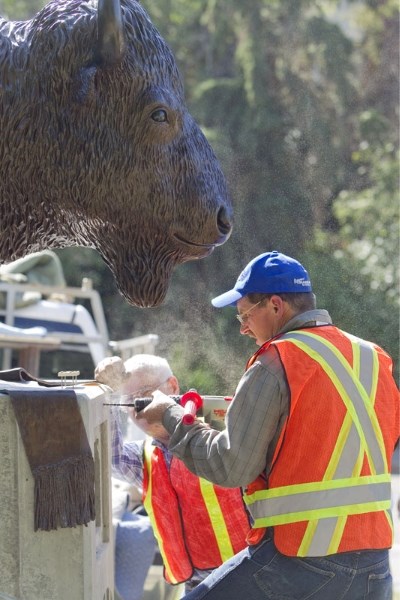The mighty bison is returning to St. Albert for the first time in more than 130 years. This time, it's here to stay.
It's not a real bison, mind you, but a bronze statue of the head of one of these great beasts. The new addition to the landscape was the brainchild of the St. Albert Historical Society and it spent a decade in the making.
"For the historical society to be involved in an art project, it has to have some historical connection," began Ray Pinco, the chair of the organization's board.
"For a long time, we've had an eye and an ear out to honour the buffalo hunt which was an activity of the first settlers. For the first 20 years of settlement, the first settlers – mainly the Métis, but there were a few white families that came in the mid-1870s – depended equally on the fruits of the hunt as they did on agriculture."
According to The Black Robe's Vision, the two-volume history of St. Albert, even though the bison represented "the quintessential product of trade and sustenance," its significance to the area's inhabitants was about more than just food and money.
"More than just an economical and practical means of livelihood, the buffalo hunt was a way of life to the Métis. Through the hunt, the social and political structure of the Métis society was determined."
Pinco continued.
"We wanted to honour that part of our history because, from the 1880s onward, the buffalo had disappeared and that activity disappeared too. Buffalo were almost extinct."
The animal was commonly known as a buffalo but in reality was a member of the bison family.
The sculpture
The Buffalo Hunt measures approximately 125 cms (49.5 inches) tall and weighs about 363 kg (800 lbs.). It was created by Don and Shirley Begg of Cochrane. They are well respected in the artistic community for their historically authentic and meticulously detailed and lifelike sculptures.
"They have a very good reputation," Pinco stated.
Begg stated that this piece, like all of their other works, is approximately one-third larger than life sized. This is done in order to maintain the right amount of presence when viewed from a distance.
The artists were awarded Alberta Centennial medals for their achievements including The Fallen Four Memorial in Mayerthorpe among several other famous and notable monuments.
The concrete base features a design of separate thick vertical lines that end in a curve to give the appearance of a broken wave across all of the lines. Pinco explained that the wave represents the river while the lines represent the riverlots.
Heidi Alther, visual arts co-ordinator with the city and liaison for this project, was pleased with the installation.
"It has been a good year," she began, referring to a number of public arts and culture projects, the latest ones being the Community Recognition monument and the Founders' Walk, both unveiled in July.
"I'm sure that it's no coincidence that it's the 150th celebration year. There's a lot of groups that are wanting to do something special."
Pinco mentioned that the St. Albert Historical Society is still working to fundraise to cover the full cost of the statue. He said that once that is accomplished, the society would donate it to the city.
"We would welcome any donations and we will recognize all of those."
To help with this effort, please call the society at 780-459-5119 or make contact via email at [email protected].
The Buffalo Hunt gets its grand unveiling at a ceremony this morning at 11 a.m. It is located on the southeast corner of the intersection where Sir Winston Churchill Avenue crosses between Perron Street and Green Grove Drive. The site was formerly used as the location of the city's memorial cenotaph until it moved to St. Anne Street sometime in the 1980s.




